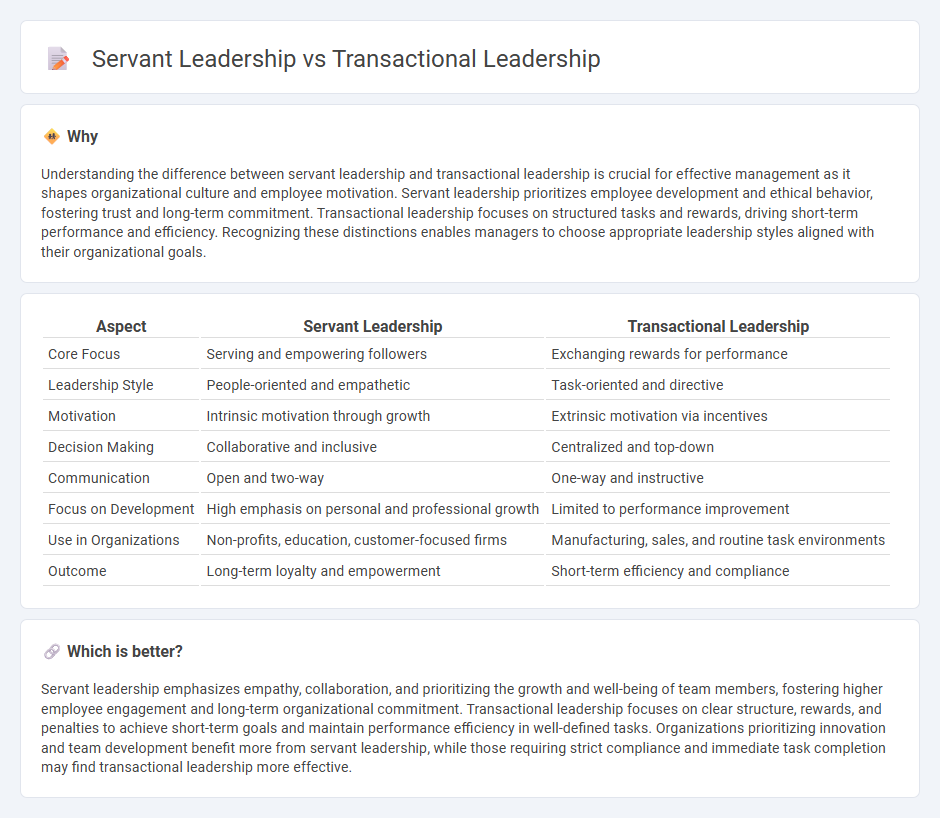
Servant leadership centers on empowering and serving team members to foster collaboration, trust, and long-term growth, while transactional leadership focuses on structured tasks, clear roles, and reward-based performance management to achieve short-term objectives. Understanding the contrasts between these leadership styles is essential for aligning management strategies with organizational goals and employee motivation. Explore deeper insights into how servant and transactional leadership can impact organizational success and team dynamics.
Why it is important
Understanding the difference between servant leadership and transactional leadership is crucial for effective management as it shapes organizational culture and employee motivation. Servant leadership prioritizes employee development and ethical behavior, fostering trust and long-term commitment. Transactional leadership focuses on structured tasks and rewards, driving short-term performance and efficiency. Recognizing these distinctions enables managers to choose appropriate leadership styles aligned with their organizational goals.
Comparison Table
| Aspect | Servant Leadership | Transactional Leadership |
|---|---|---|
| Core Focus | Serving and empowering followers | Exchanging rewards for performance |
| Leadership Style | People-oriented and empathetic | Task-oriented and directive |
| Motivation | Intrinsic motivation through growth | Extrinsic motivation via incentives |
| Decision Making | Collaborative and inclusive | Centralized and top-down |
| Communication | Open and two-way | One-way and instructive |
| Focus on Development | High emphasis on personal and professional growth | Limited to performance improvement |
| Use in Organizations | Non-profits, education, customer-focused firms | Manufacturing, sales, and routine task environments |
| Outcome | Long-term loyalty and empowerment | Short-term efficiency and compliance |
Which is better?
Servant leadership emphasizes empathy, collaboration, and prioritizing the growth and well-being of team members, fostering higher employee engagement and long-term organizational commitment. Transactional leadership focuses on clear structure, rewards, and penalties to achieve short-term goals and maintain performance efficiency in well-defined tasks. Organizations prioritizing innovation and team development benefit more from servant leadership, while those requiring strict compliance and immediate task completion may find transactional leadership more effective.
Connection
Servant leadership and transactional leadership are connected through their focus on achieving organizational goals by influencing employee behavior, though they employ different methods; servant leadership prioritizes serving employees' needs to foster growth and commitment, while transactional leadership relies on structured rewards and punishments to motivate performance. Both leadership styles play essential roles in management by balancing relational dynamics and task-oriented objectives. Understanding the interplay between these styles enhances leadership effectiveness and organizational success.
Key Terms
Authority
Transactional leadership centers on authority through a system of rewards and punishments to achieve compliance and organizational goals efficiently. Servant leadership, however, emphasizes authority as a tool for supporting and empowering team members, prioritizing their development and well-being. Explore the distinct impacts of these leadership styles on workplace dynamics and outcomes.
Motivation
Transactional leadership centers on motivating employees through rewards and punishments based on task performance, emphasizing clear structures and goals. Servant leadership prioritizes intrinsic motivation by fostering personal growth, empathy, and meaningful relationships within the team. Discover how these distinct motivational approaches impact organizational success and employee satisfaction.
Focus
Transactional leadership centers on achieving specific tasks and performance goals through structured rewards and punishments, emphasizing efficiency and short-term results. Servant leadership prioritizes the growth, well-being, and empowerment of team members, fostering a supportive environment that enhances collaboration and long-term development. Explore more about how these leadership styles impact organizational culture and success.
Source and External Links
Defining Transactional Leadership - Transactional leadership is a structured management approach that uses rewards and reprimands to motivate employees, focusing on short-term goals and strict guidelines.
Transactional leadership - Wikipedia - This style emphasizes an exchange of skills and resources between leaders and subordinates, focusing on contingent rewards and management-by-exception.
What Is Transactional Leadership? - Transactional leadership is a management style that rewards self-motivation and reprimands underperformance, often used to achieve short-term goals effectively.
 dowidth.com
dowidth.com